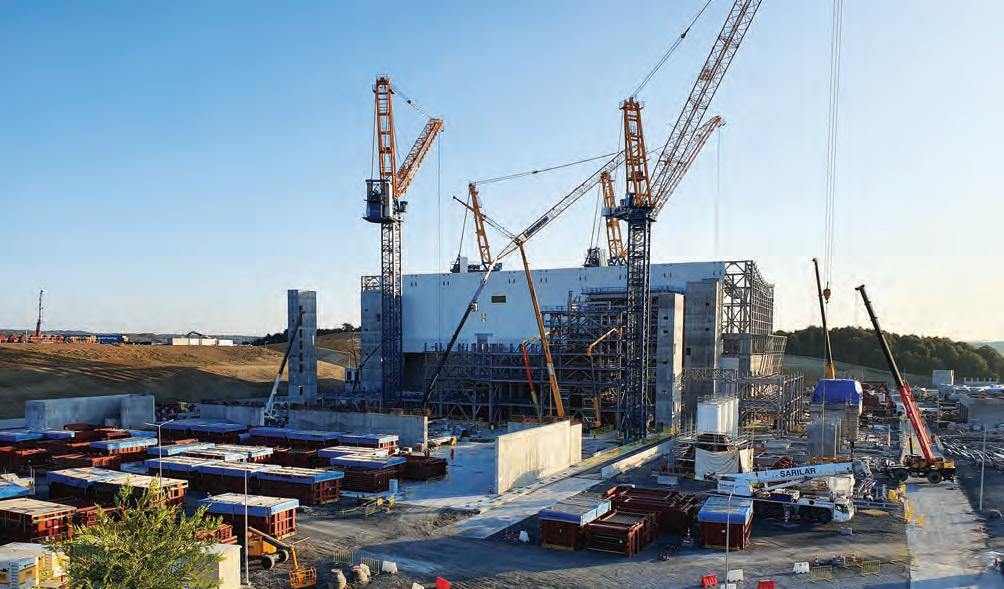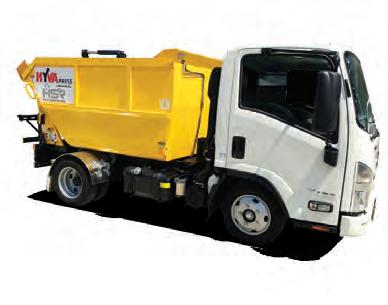
13 minute read
TRANSCONTINENTAL COMBUSTION
Hitachi Zosen Inova’s Istanbul waste-to-energy facility will process up to one million tonnes of waste per annum.
CARSTEN KAISER AND MARC STAMMBACH OF HITACHI ZOSEN INOVA SPEAK TO WASTE MANAGEMENT REVIEW ABOUT TECHNOLOGY INSTALLED ON
EUROPE’S LARGEST WASTE-TO-ENERGY FACILITY IN ISTANBUL.
Straddling Europe and Asia, Turkey’s capital is a transcontinental centre known for colourful labyrinth-like bazaars and the iconic Blue Mosque.
While perhaps not as recognisable outside of Turkey, within the country, Istanbul is also identified by the tragic Umraniye-Hekimbasi open dump explosion.
The explosion, which took place in April 1993, was the result of unsustainable and unregulated solid waste dumping, with the site receiving more than 2000 tonnes of uncompacted solid waste each day.
The event engulfed 11 houses, causing the death of 39 people.
In a recent op-ed for the DailySabah, Mehmet Emin Birpınar, Turkey’s Deputy Environment Minister, argued that the event spurred major environmental reform. Specifically, Mr Birpınar highlighted that in the preceding 25 years, Turkey’s recycling rate rose from one to 12 per cent.
While the country is now working towards “zero waste” legislation, much of that initial environmental reform focused on sanitary and well-regulated landfills.
Despite this representing an initial step in the right direction after widespread open dumping, the solution is now no longer sustainable.
Istanbul’s population is growing, according to Carsten Kaiser, Hitachi Zosen Inova (HZI) Senior Sales Manager, and putting pressure on the city’s existing landfills. He adds that throughout the region, landfills are close to capacity.
To address the problem, the Istanbul Metropolitan Municipality engaged HZI and Turkish construction partner Makyo to construct and operate a waste-to-energy (WtE) facility for municipal solid waste.
Once complete, the plant will be the first to operate in Turkey and the largest of its kind in Europe.
“The facility will process up to one million tonnes of waste per annum and will be located close to Istanbul’s

Hitachi Zosen Inova’s thermal waste-to-energy process is an environmentally sound solution for modern cities.
new airport in the northwest of the city,” Carsten says.
“HZI’s three combustion lines will process roughly 15 per cent of the city’s municipal solid waste every year and generate around 70 megawatts of net electricity.”
He adds that the plant will process roughly 25 per cent of the European side of Istanbul’s daily waste.
TECHNO-ECONOMICAL PARAMETERS As a Switzerland-based globally operating engineering, procurement and construction contractor, HZI has delivered more than 600 WtE plants worldwide.
“Our solutions are based on efficient and environmentally sound technology, are thoroughly tested, can be flexibly adapted to user requirements and cover the entire plant lifecycle,” Carsten says.
“To enable us to work even closer to our clients, we actively foster good working relations with our branch and regional offices, which is how we first came into contact with the Istanbul Metropolitan Municipality.” HZI’s first conversations with the

Hitachi Zosen Inova and Turkish construction company Makyol were awarded the facility’s design and construction contract in 2017.
Istanbul Metropolitan Municipality started in early 2013, Carsten says, before a competitive tender process began for the project in 2016. He adds that diversion from landfill, which still accounts for 84 per cent of the city’s waste disposal, was a key priority for the city.
As the fifth largest city in the world, it should come as no surprise that Istanbul has to deal with large volumes of waste, Carsten says, producing upwards of six million tonnes of solid municipal waste each year.
“Six international consortia participated in the tender, before HZI and Makyol were awarded the contact including operations and maintenance of the facility for a minimum of one year in September 2017,” Carsten says.
“The tender evaluation was based on techno-economical parameters, for example, considering the investment and operations costs, but also the overall efficiency of the facility.”
The planning process for a facility of this scale is similar to a standard WtE plant, Carsten says, with differences more apparent during execution.
“We approached our design for this facility like we would any other WtE plant – we just scaled it up. Once construction is complete, however,
everything will become bigger and faster,” he says.
The facility’s core technology components include a moving combustion gate, boiler design and efficient flue gas treatment systems. This combination of components is an example of HZI’s thermal WtE process, which Carsten says represents an efficient, environmentally sound solution for modern cities.
“Waste is delivered to the site and stored in a bunker, before a crane both thoroughly mixes and feeds the waste into a feed hooper. From there, material is pushed onto the grate by a ram feeder,” Carsten says.
“A fully integrated control system ensures stable and efficient operation and optimised fire position on the grate. Upon combustion completion, the remaining inert ashes fall into the bottom ash extractor. From there, they’re taken to a bunker or storage area for metals recovery.”
Gases released from the waste are mixed with secondary air and recirculated flue gases above the grate, Carsten says.
He adds that this process assures complete combustion and lowers carbon monoxide, nitrous oxides, and volatile organics emissions.
“The recirculation of flue gases also increases the plant’s energy efficiency,” he says.
Released energy is then used to produce superheated steam, Carsten explains, which is expanded in a turbine generator to produce electricity. Following this, flue gases are cleaned to strictest standards, and constantly monitored before being released at the stack.
All electricity produced at the site will be exported to the national electricity grid via 154-kilo volt substations at Tasoluk and Habibler, villages northwest of Istanbul. Carsten says technical controls will be installed to meet all EU Industrial Emissions Directives.
According to Carsten, over 20 per cent of the facilities components will be sourced in Turkey from local businesses.
He adds that construction is, and will continue to be, carried out exclusively by local workers.
This, he says, highlights HZI’s commitment to engaging and supporting the communities in which they operate.
“HZI strived to maximise the local scope of the supply chain in Turkey,” he says.
“While Turkey provides great opportunities in various aspects of the supply chain for a WtE plant, special equipment parts, for example the pressure parts of the boiler for such a large size of thermal output, are limited, and had to be procured from other European suppliers.”
The majority of construction is
ISTANBUL / TURKEY

estimated to be complete by the end of 2020, with the facility fully operational by 2021.
“With the realisation of this prestigious project, another region devotes itself to an ecological and sustainable waste management system, and contributes to worldwide decarbonisation and a reduction of other harmful emissions,” Carsten says.
LEARNING FROM ISTANBUL As a global supplier of WtE technologies, HZI has a range of other projects under construction throughout the world, including Australia’s East Rockingham facility near Perth, Western Australia.
The state-of-the-art facility, which will process 300,000 tonnes of municipal and industrial waste each year, will be part-owned and cooperated by HZI.
The facility reached financial close earlier this year, and as the country’s largest WtE facility, is set to serve as the missing link in Australia’s waste hierarchy. The Western Australian facility is set to be fully operational by 2022.
Marc Stammbach, HZI Australia Managing Director, says the plant’s key technology components, such as a moving combustion grate, boiler design and flue gas treatment system, are similar to those employed in Istanbul.
He adds however that while the Istanbul plant features three combustions lines, the East Rockingham facility will operate just one.
Marc explains that this comes down to the scale of the facility, Western Australia’s population and associated throughput.
East Rockingham will generate 29 megawatts of renewable energy and is the first facility of its kind to use ‘wastearising’ contracts.
The contracts provide flexibility to councils to maximise recycling and meet waste reduction targets.
Marc says he hopes the Australian facility will be the first of many developed by HZI across the country.
“Even though there is no official ban on landfill in Australia, people have been rethinking sustainability and efficient waste management for some time.
“As one of the first of its kind in the country, East Rockingham will play a pioneering role and point the way forward for future WtE installations in Oceania,” Marc says.
“For HZI, this project marks our entry into the Australian market and introduces our world renowned and leading technology to Australia – something we’ve been working on for a long time.
“For the Perth area, this project marks a major step towards sustainability and renewable WtE,” Marc says.
In addition to East Rockingham, Marc says HZI is preparing for Australia’s renewable future via other avenues.
“Considering the large Australian footprint available for wind and solar, we can see a future where Australia becomes fully sustainable and a net exporter of renewable energy,” he says.

Over 20 per cent of the facilities components will be sourced from Turkey.
TIPPING HANDLING LIFTING COMPACTING






WE MOVE YOUR WORLD
T I P P I N G S Y S T E M S OUR TIPPING SOLUTIONS ARE DESIGNED TO DELIVER THE VERY HIGHEST LEVELS OF SAFETY, RELIABILITY AND PERFORMANCE IN ALL OPERATING CONDITIONS.
CO N TA I N E R HANDLING WITH PROVEN STRENGTH AND DURABILITY YOU GET AN UNRIVALLED RANGE OF STANDARD AND OPTIONAL FEATURES TO MEET ANY CUSTOMER REQUIREMENT - WHATEVER THAT MAY BE.
L I F T I N G AND LOADING PRECISION LIFTING. MAXIMUM PAYLOAD. TRUE RELIABILITY. EACH ONE OF OUR CRANES, LIGHT, BIG OR SPECIAL LIFTING, GIVES YOU EXACTLY WHAT YOU NEED FOR EFFICIENT,
WA S T E MANAGEMENT DESIGNED TO KEEP OPERATIONAL COSTS TO A MINIMUM, OUR RANGE OF HIGH-COMPACTION WASTE HANDLING PRODUCTS OFFERS A SOLUTION TO MEET EVERY REQUIREMENT.
HYVA PACIFIC 72 GLENWOOD DRIVE, THORNTON NSW 2322 (02) 4966 3777 WWW.HYVA.COM
HSR SOUTHERN CROSS 35 HOLBECHE RD, ARNDELL PARK NSW 2148 1300 HYVA LIFT (1300 4982 5438) WWW.HSRSX.COM.AU
www.hyva.com
Conflicting WtE messages
COLIN BARKER OF THE AUSTRALIAN INDUSTRIAL ECOLOGY NETWORK EXPLAINS WHY AN ORGANISATION THAT ADVOCATES FOR INDUSTRIAL ECOLOGY WOULD HOST THE WASTE-TO-ENERGY FORUM.
Despite five consecutive years of involvement, Colin Barker, Australian Industrial Ecology Network (AIEN) Chairman, is still commonly asked why, as an industrial ecology organisation, AIEN chooses to host the Australian Waste to Energy Forum.
Established in 2014 to promote and facilitate industrial sustainability through the application of industrial ecology, AIEN advocates via policy formation, business practice and education.
Industrial ecology, broadly, refers to the study of material and energy flows through industrial systems. The global industrial economy can be modelled as a network of industrial processes that extract resources from the Earth and transform them into commodities. Under the industrial ecology framework, the goal is to minimise the environmental impact of that process.
The question of why host the Waste to Energy Forum, Colin says, generally stems from a belief that waste-to-energy (WtE) conflicts with circular economy and industrial ecology principals.
“This particular belief often results from simply equating WtE with combustion processes. WtE technologies are far broader and incorporate technologies such as anaerobic digestion, pyrolysis and gasification to name a few. All of these technologies have an important place in
Colin Barker says AEIN endorses the concept of Highest Net Resource Value.

industrial ecology and the transition to a circular economy,” he says.
According to Colin, where energy recovery is considered an option only for otherwise non-recyclable materials, WtE can align with industrial ecology objectives. He adds that even under the highest functioning circular economy, non-recyclable materials of high calorific value will likely exist, at least for the foreseeable future. While WtE is not a new concept or practice, Colin suggests there are a number of misunderstandings around the terminology. It encompasses many technologies, he says, all of which can be deployed safely. He adds that the idea that growth in WtE will undercut or undermine recycling is not consistent with factual analysis.
“Within the concept of a circular economy, AIEN recognises the need to recover materials prior to assessing opportunities for WtE technologies. The AIEN understands that there are already well-established technologies and emerging processes and supply chains available for recycling and reusing mixed plastics, rubber, glass, timber and aggregates as valuable resources in higher value-added product markets,” he says.
With this in mind, Colin says AIEN endorses the concept of Highest Net Resource Value (HNRV), highlighting it as worthy of detailed consideration and promotion.
“It’s a concept enshrined within the waste hierarchy, but with a more tangible and measurable output,” he says.
HNRV, Colin explains, reflects an approach that seeks to achieve or retain the highest possible resource value from materials under consideration, net the cost and effort to achieve that outcome.
“The waste hierarchy is normally presented only in the context of environmental/social good. AIEN has re-imagined it as representing the notional value applied to a given ‘resource’,” he says.
At the low end, disposal to landfill implies the generator places a negative value on the resource. At the high end, the generator places full commercial value upon the resource
through avoidance, prevention and/ or minimisation, suggesting an absence from the waste stream.
In certain circumstances, including remote geographic locations, Colin says small and highly diffuse resource quantities suggest there may be valid arguments that energy recovery fits within the HNRV. He adds however that it would be lazy to settle for lower resource values simply for ease and expedience.
“As such, the AIEN argues WtE should only be considered where HNRV alternatives have been fully saturated with the resources they require.”
Additional circumstances include considering where energy recovery is the only feasible process to extract economic value from resources otherwise sent to landfill, or where proponents have well-defined projects.
To further establish this message, Colin says, the AIEN adopted the Five Pillars concept from work previously undertaken by Mike Haywood and Mark Ranalli. The pillars are host/ facility/site, resource and feedstock, technology, off-take agreements and funding. He says the pillars are integral to any project development process.
Beginning with host/facility/site, Colin says key considerations include distance from feedstock, energy load profiling and space for the project’s system’s footprint. Key to determining the economic viability of a project, Colin says, is working out the duration and value of off-take agreements for the products and co-products of the onsite generation system. The AIEN believes, Colin explains, that failure to ensure appropriately developed and defined strategies are established for each pillar could be catastrophic for any project.
“Although these pillars are stand alone, they are inextricably linked. While a project may have one, two or three pillars well determined as viable and optimal for a project, without all five pillars prudently vetted, it’s likely the project will fail from a practical, technical or economic viability perspective,” Colin says.
This risk of failure and/or resulting environmental challenges, is a key driver for AIEN’s involvement in the Waste to Energy Forum.
“As proponents of industrial ecology, and passionate advocates for the transition to a circular economy, it’s our job to make sure people are informed enough to make sustainable WtE decisions, which is what we try to achieve at the Waste to Energy Forum.”

Australians are hitting tyre waste targets.
The figures are in and we couldn’t be more pleased to share the results of our latest report with you.
Our extensive audit on the Australian tyre industry provides positive figures on the amount of end-of-life tyres being recovered, sustainably reprocessed and repurposed as new and useful products.




